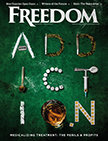Antimicrobial resistance is a growing, worldwide public-health concern, hampering doctors in their treatment of infectious disease, and even having the potential to make much of the practice of modern medicine unsafe.
Dr. Amesh Adalja, an infectious disease specialist and Senior Associate for Health Security at the University of Pittsburgh Medical Center, says that while the threat of growing antibiotic resistance is immediate and dire, common sense can go a long way toward reversing the trend. And in combination with medical science finding infectious disease treatments that don’t require antibiotic intervention, humankind can greatly mitigate the threat of antibiotic resistant ‘superbugs.’

No new class of antibiotics has been discovered since 1987. Every existing bacterium is identified as having drug-resistant strains. The effectiveness of current medicines continues to decline. How concerned should we be?
Very. Antibiotic resistance is going to be the biggest threat to public health over the next five years—and beyond. It isn’t like this is something far off in the future; it’s happening now. The increase in resistance has been particularly alarming over the past 10 years, and infectious disease physicians like myself are dealing with it on a daily basis. The bacteria out there now have mutated to the point of being resistant to multiple antibiotics. Crafting a treatment regimen that will work is growing increasingly difficult.
I don’t mean to sound ominous, but the possibility of our seeing a total return to the primitive era before antibiotics were introduced, where people die of common infections that can’t be controlled, is real.
That’s a fairly dire warning. Why aren’t others who speak publicly on this topic as blunt?
Actually, many have been equally blunt. I think people and the press simply weren’t taking [the issue of antimicrobial resistance] as seriously as they should have. Now the reports are starting to back up the predictions. The resistance to antibiotics once was rare and now is common. More and more often, no matter what combination [of antibiotic drugs] doctors throw at an infection, they can’t stop its progression in any conventional fashion. The treatment protocols of choice simply are not effective anymore. That is beyond debate.
What factors contribute to antibiotic resistance? Is it simply irresponsible prescribing of antibiotics?
That’s absolutely the primary issue. Patients mistakenly believe that antibiotics are a panacea to treat every type of condition and physicians acquiesce, prescribing them for conditions that clearly are viral, like the flu. Antibiotics treat only bacterial infections, and every time you misuse them their overall effectiveness drops.
Alexander Fleming [whose serendipitous discovery and isolation of penicillin marks the start of modern antibiotics] warned of this phenomenon back in the 1940s. He was largely ignored. But he was right. And as a result, there are situations where I have to tell patients, “I’m sorry, but modern medicine has nothing to offer you to treat this.”
A recent report from the British National Risk Register of Civil Emergencies warned that 80,000 people could die in the widespread outbreak of an antibiotic-resistant blood infection. Does this strike you as alarmist?
I’m not one to make predictions like that. What I do know is that resistant strains continue to rise—and it’s extremely difficult to quantify the severity. I’ll tell you why. Many of the people who die from antibacterial infections are already debilitated and chronically ill, or their immune systems are compromised due to age. So it’s difficult to attribute exactly how resistant infections factor into the mix.
In [elderly and chronically ill] populations, deaths from infection cause no real alarm, because infection was one of many issues. When this starts impacting children, that’s where people take notice and drive awareness to a whole new level.
The same UK report concluded that the risk of antibiotic-resistant infections could render much of the practice of modern medicine unsafe. What exactly does that mean?
What we’re talking about is no less than the entire range of medical procedures taking on a genuine risk. How can you safely perform knee surgery if the prophylactic antibiotic you give to prevent preoperative infection may not work? All surgeries, all transplants and all chemotherapy put people at heightened risk of infection without effective antibiotics. In point of fact, we’re looking at the possibility of not being able to do these now common forms of medical intervention at all.
If the frightening pace at which antibiotic resistance is moving can’t be controlled, you’re looking at a world where the risk outweighs the potential benefits of much that we do in medicine. Antibiotic resistance has the potential to greatly limit not only the way we treat infectious disease but day-to-day procedures in hospitals as well.
Can’t medical science just develop stronger and stronger antibiotics?
Bacteria have been on the planet far longer than human beings. As a result, they are highly evolved and able to mutate at a much faster rate and essentially outcompete us. As soon as we develop an antibiotic, it’s met with resistance. It happens almost immediately. So while we are introducing newer and stronger antibiotics all the time, the bacteria will always be a step ahead.
Resistance is essentially the microorganisms developing their own defense mechanisms. When we squander antibiotics—use them inappropriately as we have—we both weaken the effectiveness of the medication and hasten the evolution of resistant bacterial strains. It’s rather a perfect storm.
What can be done about this? Can science stay a step ahead of the bugs?
Yes, there’s a way to slow down antibiotic resistance, if not arrest it entirely—and it’s really just a matter of common sense.
We need to become smarter in how we use antibiotics. We must start an educational campaign so the public understands they must stop demanding antibiotics when they clearly are not indicated. At the same time, we in the medical community need to develop new methods to treat infectious disease that require no antibiotic intervention, such as therapy that directly targets cells.
This isn’t going to be easy. We have an awful lot of ground to make up and must attack the resistance on many fronts simultaneously. What we absolutely can’t do is continue down the same path, because it simply isn’t possible to get out ahead of the bacteria. Bacteria are crafty and highly advanced, and in resisting antibiotics they’re simply doing what comes naturally.
We have no time to waste in getting out in front of this.





























